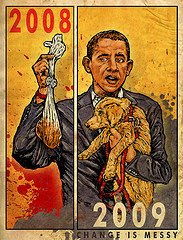CNS News reports:
Fannie Mae and Freddie Mac were the chief culprits in the housing crisis because they encouraged people who could not afford payments to borrow money, according to a congressional report released Tuesday.
The claims in the report have long been advanced by conservatives, who argue that the Community Reinvestment Act and other federal programs fed the housing bubble that burst in 2007 and led to the economic downfall in 2008.
But the report explains in detail how Fannie and Freddie -- government sponsored enterprises (GSE) that were not subject to the same oversight as other publicly traded firms -- “privatized their profits but socialized their risks.”
“In the short run, this government intervention was successful in its stated goal – raising the national homeownership rate,” says the report, the result of an investigation launched last fall by Republican members of the House Oversight and Government Reform Committee.
“However, the ultimate effect was to create a mortgage tsunami that wrought devastation on the American people and economy,” says the report. “While government intervention was not the sole cause of the financial crisis, its role was significant and has received too little attention.”
The report talks about the Clinton administration’s National Homeownership Strategy, citing President Clinton’s directive to “lift America’s homeownership rate to an all-time high by the end of the century.”
The Clinton strategy further said that Freddie and Fannie should reduce down-payment requirements and, according to the report, “called for increased use of ‘flexible underwriting criteria,’ which it said could be achieved in concert with ‘liberalized affordable housing underwriting criteria.’”
“That is the perfect smoking gun that tells how Barney Frank [D-Mass.], the Clinton administration and others would do it in those days,” Rep. Darrell Issa (R-Calif.), the ranking member on the House Oversight and Government Affairs Committee, said Tuesday in a speech at the Heritage Foundation.
“The seeds of the meltdown began with the well-intentioned goal that everyone have a home even if they can’t afford it,” he said. “It led to one of the biggest ponzi schemes ever.”
Read the full report here.
U.S. House of Representatives
Committee on Oversight and Government Reform
Darrell Issa (CA-49), Ranking Member
The Role of Government Affordable Housing Policy in
Creating the Global Financial Crisis of 2008
The housing bubble that burst in 2007 and led to a financial crisis can be traced back to federal government intervention in the U.S. housing market intended to help provide homeownership opportunities for more Americans. This intervention began with two government-backed corporations, Fannie Mae and Freddie Mac, which privatized their profits but socialized their risks, creating powerful incentives for them to act recklessly and exposing taxpayers to tremendous losses. Government intervention also created “affordable” but dangerous lending policies which encouraged lower down payments, looser underwriting standards and higher leverage. Finally, government intervention created a nexus of vested interests – politicians, lenders and lobbyists – who profited from the “affordable” housing market and acted to kill reforms. In the short run, this government intervention was successful in its stated goal – raising the national homeownership rate. However, the ultimate effect was to create a mortgage tsunami that wrought devastation on the American people and economy. While government intervention was not the sole cause of the financial crisis, its role was significant and has received too little attention.








